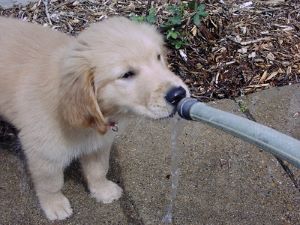
Taking your new puppy home can be as stressful as the first days caring for a newborn baby, as the little one has no way of telling you what it needs.
Many pet parents worry over how much water their puppy should drink and their immediate concern is that they don’t get enough.
Obviously, dehydration is a serious concern, but you shouldn’t fly into a panic if the puppy doesn’t drink all the water you’d expect him to do or when you think he should.
In this article we’ll examine how much water a puppy needs, the most frequent reasons why he refuses to drink and what you can do about it.
We have a list of tricks you can use to keep even the most stubborn puppy hydrated.
How much water does a puppy need?
It is difficult for a new pet parent to determine just how much water their little furry friend actually needs. That depends on the puppy’s age and weight.
In the first weeks of their lives, puppies satisfy their hydration needs with their mother’s milk.
However, once the weaning process starts and the puppy begins to eat solids he will also need water, around half a cup or 2oz every two hours.
Since most pet parents take the puppies home when they’re fully weaned, they’ll be completely in the dark about the little guy’s water needs.
According to experts, a weaned puppy needs between 1/2 a 1 oz of water per pound of body weight per day.
Any amount of water within these limits should be fine, although on hot days or when the puppy is very active exploring his new surroundings and playing with the kids you should give him a bit more.
An adult dog needs one ounce of water per pound of body weight per day. Generally, a dog that eats dry food will need more water than one who gets wet food.
Now, let’s have a look at the most common situations when a puppy refuses to drink.
Puppy not drinking water the first day in his new home
The most common reason your new puppy won’t touch the brand new bowl of water you’ve bought him is exactly that it’s new and unfamiliar.
And it’s not just about the bowl. The smell of the water might be unfamiliar, too.
Keep in mind that dogs have a more powerful sense of smell than we do so he will be able to detect the smallest difference.
Do not force the dog to drink if he doesn’t want to, but you should try to wet his lips with a little water from the bowl.
Use a bit of cloth for that or even your finger. At some point he’ll understand it’s just water and, when he’s thirsty enough he’ll drink.
Another trick is to change the type of water in the bowl. If you have bottled water, pour a bit in his bowl and see if it smells or tastes better than tap water.
If the puppy is quite adamant about refusing to drink, it could be useful to give the breeder or kennel owner a call and ask about the kind of water they gave the dogs.
Sometimes, breeders anticipate this kind of problem and give you a bottle of their water and a small bag of food when you take the dog home.
Puppy not getting enough exercise
This might be related to the fact that the dog is stressed about his new surroundings. If the dog is shy and hides in his new digs it’s best to give him time to take in his new home.
However, that means he’ll be less physically active and sweat less, so he won’t need to replace lost fluids as often.
Make sure to encourage him to explore more once he settles in. Play with him and try presenting him with a new toy, gently luring out of his corner.
Puppy not drinking or eating
If your new puppy refuses to eat or drink, that should be a cause of concern, especially if it isn’t the first day in his new home and he’s had enough time to settle in.
If you’ve just changed his food, that might explain why he refuses to eat, but not why he’s not drinking.
The first thing you need to do is check if he’s not sick.
Taking his temperature would be a good place to start. The normal body temperature for a puppy is between 99 and 102.5 degrees Fahrenheit.
Anything above that qualifies as fever and you should take him to the vet.
Remember that animals, including humans and their pets, can go much longer without food than without water.
Check for dehydration signs:
- Sunken eyes
- Dry nose or gums
- Loss of energy/Lethargy
- Loss of appetite
- Vomiting
- Diarrhea
The easiest way to detect dehydration in dogs of all ages is to do a skin elasticity test.
Get hold of a bit of skin near the shoulder blades area and raise it gently, before letting it go.
In a healthy well-hydrated dog the skin should spring back into place, but if your pet is dehydrated it won’t fall back into place easily and the crease you made will be obvious.
As odd as it may sound, dehydration makes dogs less interested in water.
As the first symptoms of dehydration set in, the puppy will refuse to drink as he’s already not feeling well and this is extremely dangerous.
If you suspect your puppy is dehydrated, head to the vet straight away. Your pet might need IV fluids and you also need to determine what’s wrong with him.
Puppy not drinking after spaying or neutering
It is normal for a puppy to show little interest in food or water during the first few hours after spaying or neutering surgery.
The stress alone would warrant that, but you also need to consider the pain he or she might be experiencing. A dog might refuse to drink just so he or she doesn’t have to pee so often.
At the same time, the puppy might still be feeling the effects or the anaesthetic and if he’s a bit confused a change in behavior is to be expected.
Also, if he’s getting pain medication it might make him feel sleepy so again he doesn’t care much about water.
Puppy not drinking or peeing
One way of checking if there’s something wrong with your dog is to monitor how often they pee. A puppy should pee every two hours or so during daytime.
If your dog gives the water bowl a wide berth and doesn’t pee, you should have him checked for urinary tract infection.
If peeing is painful, the puppy will try to hold it in as long as possible and will abstain from drinking.
Take him to the vet for a complete urine analysis. A puppy that doesn’t pee for 24 hours needs immediate medical care.
However, if the dog is peeing normally, it’s probably not an UTI so you need to look for other causes.
How long can a puppy go without water?
Dogs can survive up to 72 hours, perhaps even longer without water.
However, after 24 hours without drinking any dog will be dehydrated, and puppies can start manifesting dehydration signs earlier than that.
Experts believe a puppy can safely stay without water for no more than 6-10 hours.
No matter why the puppy refuses to drink, after 10 hours maximum you should do something about it.
Don’t wait any longer as lack of water could result in organ damage, starting with the kidneys.
Your best option would be to call the vet, but if it’s already late in the evening you should force some water down the puppy’s throat.
The easiest way to rehydrate your pet is to use a plastic syringe (without a needle) or, fail that, a turkey baster to squirt some water in his mouth.
Have someone to help you by keeping the dog’s mouth slightly open, do it as gently as you can, but do it.
It would be great if you could add some Pedialyte, an electrolyte solution used to treat diarrhea and dehydration in children.
A few drops of Pedialyte mixed in the water can help treat an electrolyte imbalance, but this is only a temporary solution, something you can do to help prevent dehydration until you can take your puppy to the vet.
Tips on keeping your dog hydrated
There are many tricks you can use to make sure your puppy gets enough water, no matter the reason why he won’t touch it.
- Change the position of the water bowl: Remove the water bowl for 30 minutes, clean it and fill it again with fresh water and when you bring it back simply put it in another spot. The puppy might get curious and by that time he might be a little more thirsty so he’ll give it a try.
- Change the water bowl: Maybe it’s something about the bowl that the dog finds weird. It could be the color or the material. Metal bowls tend to make a loud noise when moved around and the puppy might find that intimidating. Use a glass or plastic bowl instead.
- Put more water in his wet food: If the dog is not refusing to eat as well, you can simply add more water to the wet food, stir it in and and offer it to the puppy. It won’t solve the problem, but at least you’ll know he’s getting some water.
- Make the water tastier: One way of tricking your dog into drinking water is to add a bit of bone or chicken broth in his bowl. If the water smells even faintly like meat the dog might not be able to resist the temptation.
- Give him a pupsicle: Some puppies who refuse water might be tricked into eating ice chips, especially if the ice is in fact chicken or beef broth. You can freeze some broth in the ice cube tray and present the cubes as a treat, only make sure to watch your pup while he’s playing with the ice cubes as they’re a choking hazard. A better solution would be to fill a hollow toy with broth and put it in the freezer. Once it’s frozen, let the dog play with it all he wants and the melting broth will be enough to hydrate him.
Closing Thoughts
There are many reasons why a puppy might refuse to drink.
The most common problems are related to the dog finding himself in new surroundings. The stress of being in a strange place and the unfamiliar smell of the water in your house might be enough to make him refuse to drink.
At the same time, a dog might refuse water so he doesn’t have to pee very often. This is common after spaying or neutering, as well as in UTI.
Don’t let your puppy without taking any water for more than 6 – 10 hours. After 24 hours, dehydration sets in and this can lead to severe health issues or even death.
Try all the tricks mentioned above to make him take some water and take him to the vet if the situation doesn’t resolve itself by the next day.






